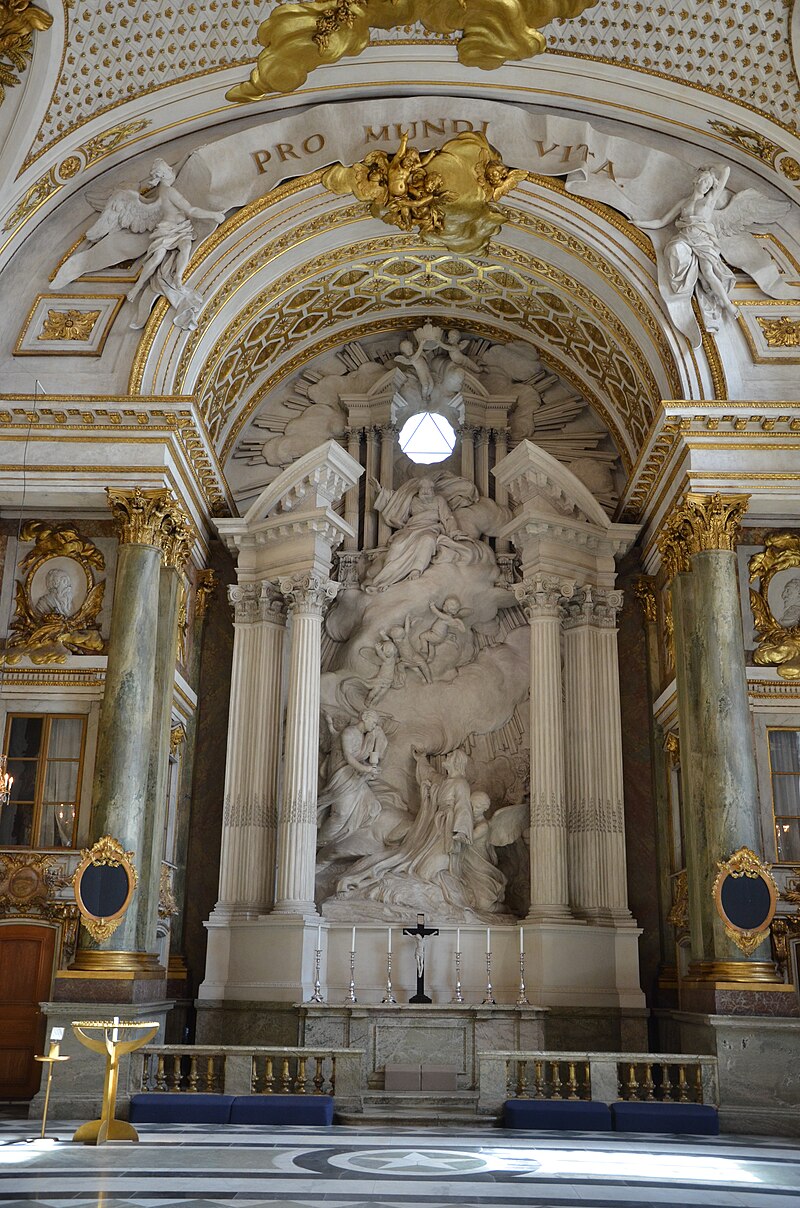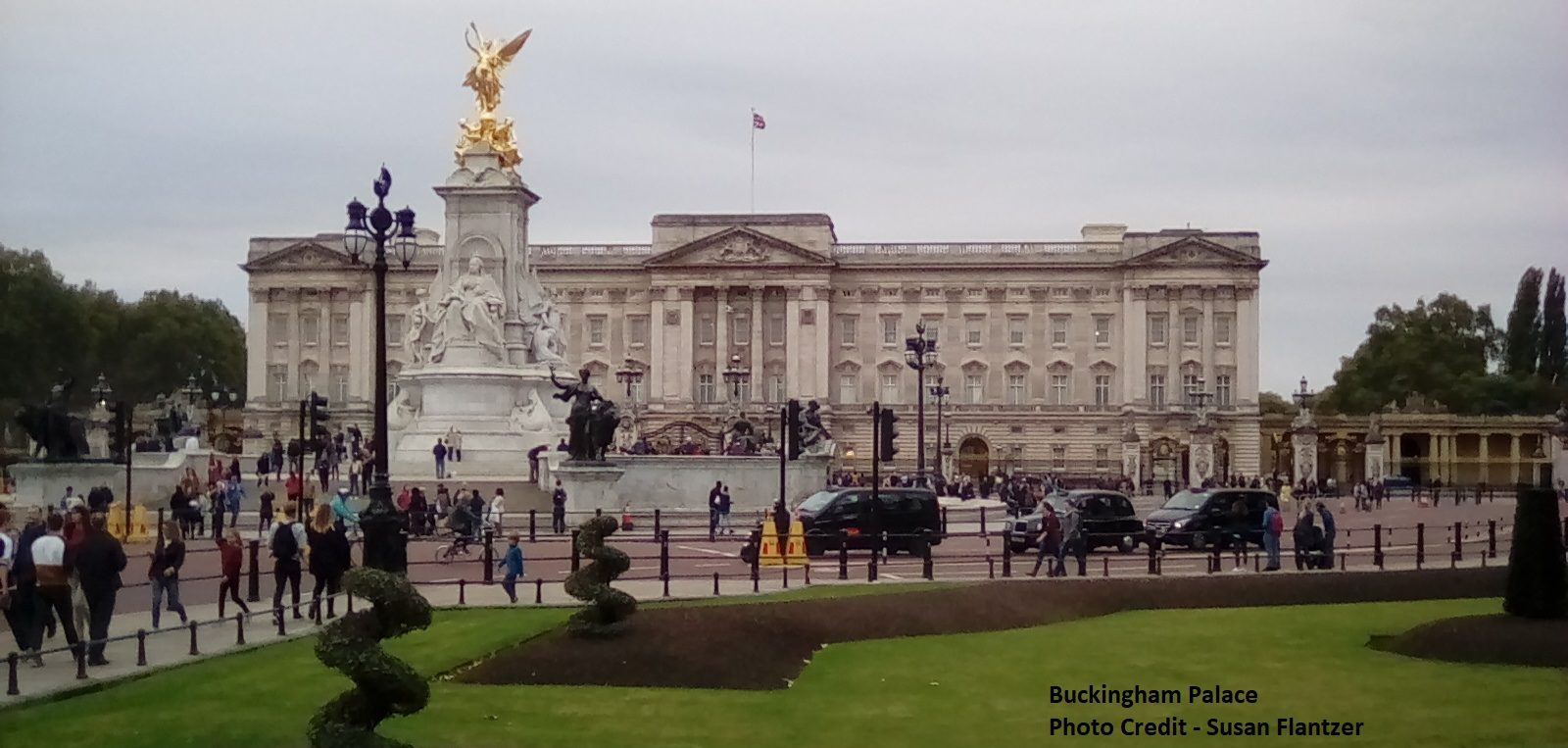by Susan Flantzer
© Unofficial Royalty 2022

The Royal Chapel at the Royal Palace in Stockholm looking toward the entrance; Credit – By Holger.Ellgaard – Own work, CC BY-SA 3.0, https://commons.wikimedia.org/w/index.php?curid=14663353
The Royal Palace is located in Gamla stan, the old town of Stockholm, Sweden. It is the official residence and major royal palace of the Swedish monarch although the actual residence of King Carl XVI Gustaf and Queen Silvia is Drottningholm Palace in Ekerö municipality on the island of Lovön in Lake Mälaren, west of Stockholm, Sweden. However, the offices of the Swedish monarch, other members of the Swedish royal family, and the Royal Court of Sweden are located at the Royal Palace.

The Royal Palace in Stockholm, Sweden; Credit – By Grishasergei – Own work, CC BY-SA 3.0, https://commons.wikimedia.org/w/index.php?curid=16370245
The current palace was built on the site of the former Tre Kroner Castle (Three Crowns Castle), built in the 13th century, which was destroyed by fire in 1697. Construction began in 1697 and was completed in 1760. The Royal Palace was designed by Swedish architect Nicodemus Tessin the Younger. After Tessin the Younger died in 1728, the Royal Palace was completed by Swedish architect Carl Hårleman who also designed a large part of its interior.
********************

The Royal Chapel at the Royal Palace in Stockholm, looking toward the altar; Credit – By Holger.Ellgaard – Own work, CC BY-SA 3.0, https://commons.wikimedia.org/w/index.php?curid=14663324
The Royal Chapel at the Royal Palace in Stockholm, which this writer has visited, is a church of the Church of Sweden, an Evangelical Lutheran church. It is the parish church for the members of the Royal Parish which comprises the Swedish royal family, employees at the court, and their relatives. Services are held every Sunday and on holy days, and the royal family uses the church for other ceremonies.

Ceiling painting and decorations of the Royal Chapel; Credit – By Ad Meskens – Own work, CC BY-SA 4.0, https://commons.wikimedia.org/w/index.php?curid=72492390
Built during the 18th century along with the rest of the Royal Palace, the Royal Chapel was consecrated in 1754. The ceiling paintings and decorations have the theme of the Ascension of Jesus Christ and were the collaborative work of Swedish architect Carl Hårleman, French painter Guillaume Taraval and Swedish decorative artist Johan Pasch and French sculptors Jacques Philippe Bouchardon (link in French) and Charles Guillaume Cousin (link in Swedish).
Thanksgiving service in 2013 marking the 40th anniversary of King Carl XVI Gustaf’s accession to the throne. There is a good view of the pulpit on the right.

A close-up view of the pulpit; Credit – By Holger.Ellgaard – Own work, CC BY-SA 3.0, https://commons.wikimedia.org/w/index.php?curid=14663388
The pulpit was created in the years 1748 -1751 mainly by French sculptor Jacques-Philippe Bouchardon.

The magnificent altarpiece; Credit – By Steven Lek – Own work, CC BY-SA 4.0, https://commons.wikimedia.org/w/index.php?curid=61789914
Jacques-Philippe Bouchardon had been working on an altarpiece but he died before it was completed. His replacement Swedish sculptor Pierre Hubert L’Archevêque damaged Bouchardon’s incomplete work out of rivalry and began his own altarpiece. L’Archevêque eventually tired of working on the altarpiece and it was completed in 1779 by Johan Tobias Sergel, one of Sweden’s greatest sculptors. The magnificent altarpiece depicts Jesus Christ in the Garden of Gethsemane. Above the altar is a banner carried by two angels with the Latin words Pro Mundi Vita, “For the world to live” from the Gospel of John.
This short video of video clips from the christening of Princess Estelle, daughter of Crown Princess Victoria, provides some views of the Royal Chapel.
*********************

The Duke of Småland’s baptism at the Royal Chapel in 1782, oil painting by Elias Martin; Credit – Wikipedia
It can be assumed that after the completion of the Royal Palace in 1754, christenings and other religious events occurred at the Royal Chapel. It is a tradition in the Swedish royal family to attend a Te Deum at the Royal Chapel to give thanks for the birth of a new royal baby within days of the birth. Some recent Te Deums are listed below.
Some royal events at the Royal Chapel at the Royal Palace in Stockholm, Sweden include:
- November 10, 1778 – Christening of the future King Gustav IV Adolf, son of King Gustav III
- 1782 – Christening of Prince Karl Gustav, Duke of Småland, son of King Gustav III; Prince Karl Gustav died at the age of six months
- October 31, 1797 – Wedding of King Gustav IV Adolf and Princess Frederica of Baden
- July 7, 1774 – Wedding of King Karl XIII and Princess Hedwig Elisabeth Charlotte of Holstein-Gottorp
- May 5, 1910 – Christening of Princess Ingrid, daughter of King Gustaf VI Adolf
- June 7, 1946 – Christening of the future King Carl XVI Gustaf, son of Prince Gustaf Adolf of Sweden, Duke of Västerbotten
- December 7, 1972 – Funeral of Sibylla of Saxe-Coburg and Gotha, Princess of Sweden, Duchess of Västerbotten, mother of King Carl XVI Gustaf
- June 15, 1974 – Wedding of Princess Christina, sister of King Carl XVI Gustaf, and Tord Magnuson
- August 31, 1979 – Christening of Prince Carl Philip, Duke of Värmland, son of King Carl XVI Gustaf
- August 31, 1982 – Christening of Princess Madeleine, Duchess of Hälsingland and Gästrikland, daughter of King Carl XVI Gustaf
- February 24, 2012 – Te Deum for the birth of Princess Estelle, granddaughter of King Carl XVI Gustaf, daughter of Crown Princess Victoria
- May 12, 2012 – Christening of Princess Estelle, Duchess of Östergötland, granddaughter of King Carl XVI Gustaf, daughter of Crown Princess Victoria
- June 8, 2013 – Wedding of Princess Madeleine and Christopher O’Neill
- September 15, 2013 – Thanksgiving service marking the 40th anniversary of King Carl XVI Gustaf’s accession to the throne
- March 2, 2014 – Te Deum for the birth of Princess Leonore, granddaughter of King Carl XVI Gustaf, daughter of Princess Madeleine
- June 13, 2015 – Wedding of Prince Carl Philip and Sofia Hellqvist
- June 18, 2015 – Te Deum for the birth of Prince Nicholas, grandson of King Carl XVI Gustaf, son of Princess Madeleine
- March 3, 2016 – Te Deum for the birth of Prince Oscar, grandson of King Carl XVI Gustaf, son of Crown Princess Victoria
- April 22, 2016 – Te Deum for the birth of Prince Alexander, grandson of King Carl XVI Gustaf, son of Prince Carl Philip
- May 27, 2016 – Christening of Prince Oscar, Duke of Skåne, grandson of King Carl XVI Gustaf, son of Crown Princess Victoria
- September 4, 2017 – Te Deum for the birth of Prince Gabriel, grandson of King Carl XVI Gustaf, son of Prince Carl Philip
- March 12, 2018 – Te Deum for the birth of Princess Adrienne, granddaughter of King Carl XVI Gustaf, daughter of Princess Madeleine
- March 28, 2020 – Te Deum for the birth of Prince Julian, grandson of King Carl XVI Gustaf, son of Prince Carl Philip
This article is the intellectual property of Unofficial Royalty and is NOT TO BE COPIED, EDITED, OR POSTED IN ANY FORM ON ANOTHER WEBSITE under any circumstances. It is permissible to use a link that directs to Unofficial Royalty.
Works Cited
- En.wikipedia.org. 2021. Stockholm Palace – Wikipedia. [online] Available at: <https://en.wikipedia.org/wiki/Stockholm_Palace> [Accessed 3 December 2021].
- Flantzer, Susan, 2019. Swedish Royal Christenings. [online] Unofficial Royalty. Available at: <https://www.unofficialroyalty.com/swedish-royal-christenings/> [Accessed 3 December 2021].
- Sv.wikipedia.org. 2021. Stockholms slott – Wikipedia. [online] Available at: <https://sv.wikipedia.org/wiki/Stockholms_slott> [Accessed 3 December 2021].
- Sv.wikipedia.org. 2021. Slottskyrkan – Wikipedia. [online] Available at: <https://sv.wikipedia.org/wiki/Slottskyrkan> [Accessed 3 December 2021].






